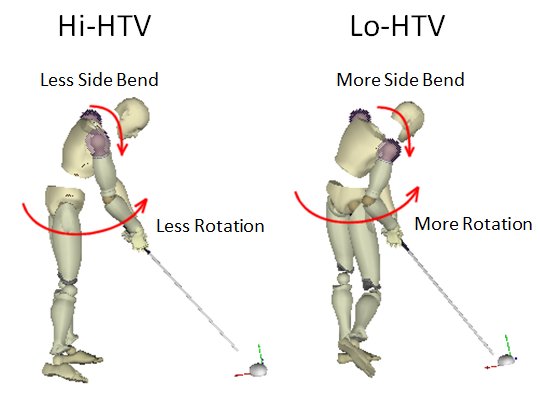The Relationship of Club Handle Twist Velocity to Selected Biomechanical Characteristics of the Golf Drive
 Abstract
Abstract
During the downswing all golfers must roll their forearms and twist the club handle in order to square the club face into impact. Anecdotally some instructors say that rapidly twisting the handle and quickly closing the club face is the best technique while others disagree and suggest the opposite. World class golfers have swings with a range of club handle twist velocities (HTV) from very slow to very fast and either method appears to create a successful swing. The purpose of this research was to discover the relationship between HTV at impact and selected body and club biomechanical characteristics during a driver swing. Three-dimensional motion analysis methods were used to capture the swings of 94 tour professionals. Pearson product-moment correlation was used to determine if a correlation existed between HTV and selected biomechanical characteristics. The total group was also divided into two sub-groups of 32, one group with the fastest HTV (Hi-HTV) and the other with the slowest HTV (Lo-HTV). Single factor ANOVAs were completed for HTV and each selected biomechanical parameter. No significant differences were found between the Hi-HTV and Lo-HTV groups for both clubhead speed and driving accuracy. Lead forearm supination velocity at impact was found to be significantly different between groups with the Hi-HTV group having a higher velocity. Lead wrist extension velocity at impact, while not being significantly different between groups was found to be positive in both groups, meaning that the lead wrist is extending at impact. Lead wrist ulnar deviation, lead wrist release and trail elbow extension velocities at maximum were not significantly different between groups. Pelvis rotation, thorax rotation, pelvis side bend and pelvis rotation at impact were all significantly different between groups, with the Lo-HTV group being more side bent tor the trail side and more open at impact. These results suggest that world class golfers can successfully use either the low or high HTV technique for a successful swing. From an instructional perspective it is important to be aware of the body posture and wrist/forearm motion differences between the two techniques so as to be consistent when teaching either method.
You can read the full dissertation and you can also see my defense presentation. The links to download both of these files will be available by clicking on the ‘Yes, I am human check box’ below.
You may use parts of my dissertation or Powerpoint in your articles but if you do please reference my material as follows:
If you want to reference the published work through ProQuest copy this citation into your docment:
Cheetham P. (2014) The relationship of club handle twist velocity to selected biomechanical characteristics of the golf drive. Doctoral dissertation. http://gradworks.umi.com/36/32/3632464.html
If you want to reference the unpublished work directly from this website copy this citation into your document:
Cheetham P. (2014) The relationship of club handle twist velocity to selected biomechanical characteristics of the golf drive. Doctoral dissertation. https://www.philcheetham.com/media/Phillip-Cheetham-Doctoral-Dissertation-2014.pdf
Acknowledgements
I would like to thank Dr. Rick Hinrichs for his guidance and many years of patience through this lengthy process, helping me bring it to its final culmination. Thanks to my committee members Dr. Shannon Ringenbach, Dr. Debbie Crews and Dr. Natalia Dounskaia for their help in clarifying my direction and providing their time while working with me to get it right. Thanks to Penny Pandelisev for helping me navigate the administrative procedures along the way and for making sure I had the right forms filled out in a timely fashion. I express my gratitude to Kelly Skinner and Finbarr Kirwan of the United States Olympic Committee for their support and for allowing me to set my PhD as a professional goal and allot time towards its completion. Thanks to Dr. Greg Rose and Dave Phillips for their knowledge in co-developing the TPI 3D biomechanical analysis with me, plus their support in allowing me to include data from swings that were captured at the Titleist Performance Institute. Also my appreciation to Dr. Paul Wood and Dr. Erik Henrikson for stepping in at the last minute with helpful data on club and shaft dynamics. My thanks to my brother, Steve Cheetham for his stewardship of AMM, keeping it on track these many years and helping me develop the AMM3D system from the beginning, with his always constructive comments. Thanks to Dr. Mary Thomas, notice I wrote “Doctor”, you may have gotten there first but I am not far behind, so thanks for the enthusiasm and encouragement from you and Dan in these last few months.
Finally, a special dedication to my wife Bridget and my daughters Mandy, Katie and Jenny for your love, support and patience over all these years and for being the reason that I strive to achieve my goals. Mandy, I started this PhD before you were born and now you are a senior at college yourself. I love you girls. This is for you. It took a long time but I finally did it!